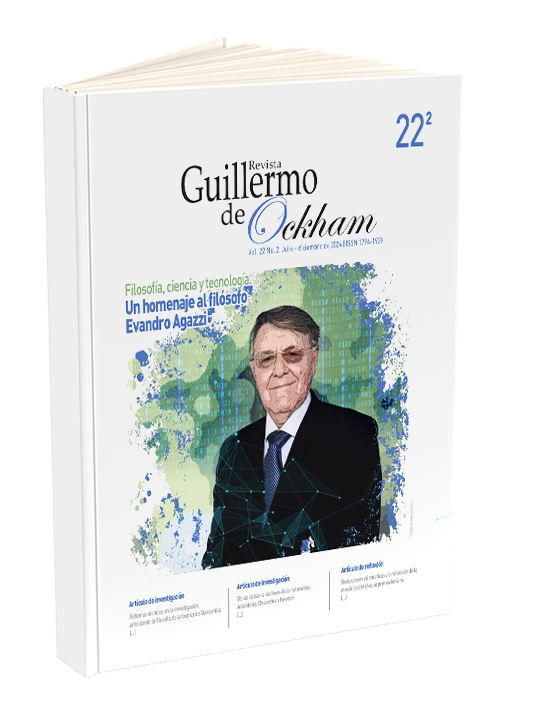La Revista Guillermo de Ockham brinda un acceso inmediato y abierto a su contenido, basado en el principio de ofrecer al público un acceso gratuito a las investigaciones para brindar un intercambio global de conocimiento. A menos que se establezca lo contrario, el contenido de esta revista tiene una licencia con Creative Commons Attribution-NonCommercial-NoDerivatives 4.0 International (CC BY-NC-ND 4.0) http://creativecommons.org/licenses/by-nc-nd/4.0/
- Atribución: debe otorgar el crédito correspondiente, proporcionar un enlace a la licencia e indicar si se realizaron cambios. Puede hacerlo de cualquier manera razonable, pero no de ninguna manera que sugiera que el licenciante lo respalda a usted o su uso.
- No comercial: no puede utilizar el material con fines comerciales.
- Sin derivados: si remezcla, transforma o construye sobre el material, no puede distribuir el material modificado.
- Sin restricciones adicionales: no puede aplicar términos legales o medidas tecnológicas que restrinjan legalmente a otros de hacer cualquier cosa que permita la licencia.
Resumen
En el presente trabajo, se reflexiona en torno al concepto de reducción eliminativa propuesto para las teorías físicas (Gutschmidt, 2014). El propósito es defender que la caracterización formal de la reducción interteórica propuesta por la concepción estructuralista muestra ventajas elucidatorias respecto de los análisis clásicos, pero aún mantiene una limitación al momento de capturar un rasgo eliminativo presente en algunos casos de reducción interteórica. Para ello, se utiliza el análisis del caso concreto de la reducción de la mecánica del choque prenewtoniana a la mecánica clásica. Este ejemplo de reducción ha sido ampliamente estudiado por la concepción estructuralista e ilustra un rasgo eliminativo que no logra capturarse en las reconstrucciones propuestas.
Palabras clave:
Referencias
Balzer, W. (1985). Incommensurability, reduction, and translation. Erkenntnis, 23(3), 255-267. https://doi.org/10.1007/BF00168293
Balzer, W., y Mühlhölzer, F. (1982). Klassische Stoßmechanik. Zeitschrift für Allgemeine Wissenschaftstheorie, 13, 22-39. https://doi.org/10.1007/BF01801183
Balzer, W., Moulines, C. U., y Sneed, J. D. (1987). An architectonic for science: The structuralist program. Reidel.
Batterman, R. (2002). The devil in the details: Asymptotic reasoning in explanation, reduction, and emergence. Oxford University Press.
Bickle, J. (1998). Psychoneural reduction: The new wave. MIT Press.
Butterfield, J. (2011a). Emergence, reduction and supervenience: A varied landscape. Foundations of Physics, 41(6), 920-959. https://doi.org/10.48550/arXiv.1106.0704
Butterfield, J. (2011b). Less is different: Emergence and reduction reconciled. Foundations of Physics, 41(6), 1065-1135. https://doi.org/10.48550/arXiv.1106.0702
Butterfield, J. (2014). Reduction, emergence, and renormalization. Journal of Philosophy, 111(1), 5-49. https://doi.org/10.48550/arXiv.1406.4354
Dizadji-Bahmani, F., Frigg, R., y Hartmann, S. (2010). Who’s afraid of Nagelian reduction? Erkenntnis, 73(3), 393-412. https://doi.org/10.1007/s10670-010-9239-x
Gutschmidt, R. (2014). Reduction and the neighbourhood of theories: A new approach to the intertheoretic relations in physics. Journal for General Philosophy of Science, 45(1), 49-70. https://doi.org/10.1007/s10838-014-9240-1
Hooker, C. (1981a). Towards a general theory of reduction. Part I: historical and scientific setting. Dialogue, 20(1), 38-59. https://doi.org/10.1017/S0012217300023088
Hooker, C. (1981b). Towards a general theory of reduction. Part II: Identity in reduction. Dialogue, 20(2), 201-236. https://doi.org/10.1017/S0012217300023301
Hooker, C. (1981c). Towards a general theory of reduction. Part III: Cross-categorial reduction. Dialogue, 20(3), 496-529. https://doi.org/10.1017/S0012217300023593
Kemeny, J. G., y Oppenheim, P. (1956). On reduction. Philosophical Studies, 7(1-2), 6-19. https://doi.org/10.1007/BF02333288
Moulines, C. U. (1984). Ontological reduction in the natural sciences. En W. Balzer, D. A. Pearce y H. J. Schmidt (Eds.), Reduction in science: Structure, examples, philosophical problems (pp. 51-70). Reidel.
Moulines, C. U. (1985). Tipología axiomática de las teorías empíricas. Crítica: Revista Hispanoamericana de Filosofía, 17(51), 41-69. https://doi.org/10.22201/iifs.18704905e.1985.587
Nagel, E. (1935). The logic of reduction in the sciences. Erkenntnis, 5, 46-52. https://doi.org/10.1007/BF00172282
Nagel, E. (1949). The meaning of reduction in the natural sciences. En R. C. Stouffer (Ed.), Science and civilization (pp. 99-135). University of Wisconsin Press.
Nagel, E. (1961). The structure of science: Problems in the logic of explanation. Harcourt, Brace & World.
Nickles, T. (1973a). Heuristics and justification in scientific research: Comments on Shapere. En F. Suppe (Ed.), The structure of scientific theories (pp. 571-589). University of Illinois Press.
Nickles, T. (1973b). Two concepts of intertheoretic reduction. The Journal of Philosophy, 70(7), 181-201. https://doi.org/10.2307/2024906
O’Lery, M. M. (2018). Reducción y estructuralismo. Perspectivas, 3(2), 121-137. https://doi.org/10.20873/rpv3n2-42
O’Lery, M. M. (2023a). Ontological reduction: The reduction of classical collision mechanics to classical particle mechanics. En C. Abreu (Ed.), Philosophy of science in the 21st century: Contributions of metatheoretical structuralism (pp. 41-60). NEL; UFSC.
O’Lery, M. M. (2023b). Análisis de un caso de reducción homogénea. En Al-Chueyr Pereira Martins, L. M. Duque Martínez, L. Federico, G. Guerrero Pino y M. M. O’Lery (Eds.), Reflexiones filosóficas e históricas: ciencia, enseñanza y política científica (pp. 129-139). AFHIC; Universidad del Valle.
Palacios, P. (2024). Intertheory relations in physics. En E. N. Zalta y U. Nodelman (Eds.), The Stanford encyclopedia of philosophy. https://plato.stanford.edu/archives/spr2024/entries/physics-interrelate/
Schaffner, K. (1967). Approaches to reduction. Philosophy of Science, 34, 137-147. https://doi.org/10.1086/288137
Shapere, D. (1973). Scientific theories and their domains. En F. Suppe (Ed.), The structure of scientific theories (pp. 518-566). University of Illinois Press.
































